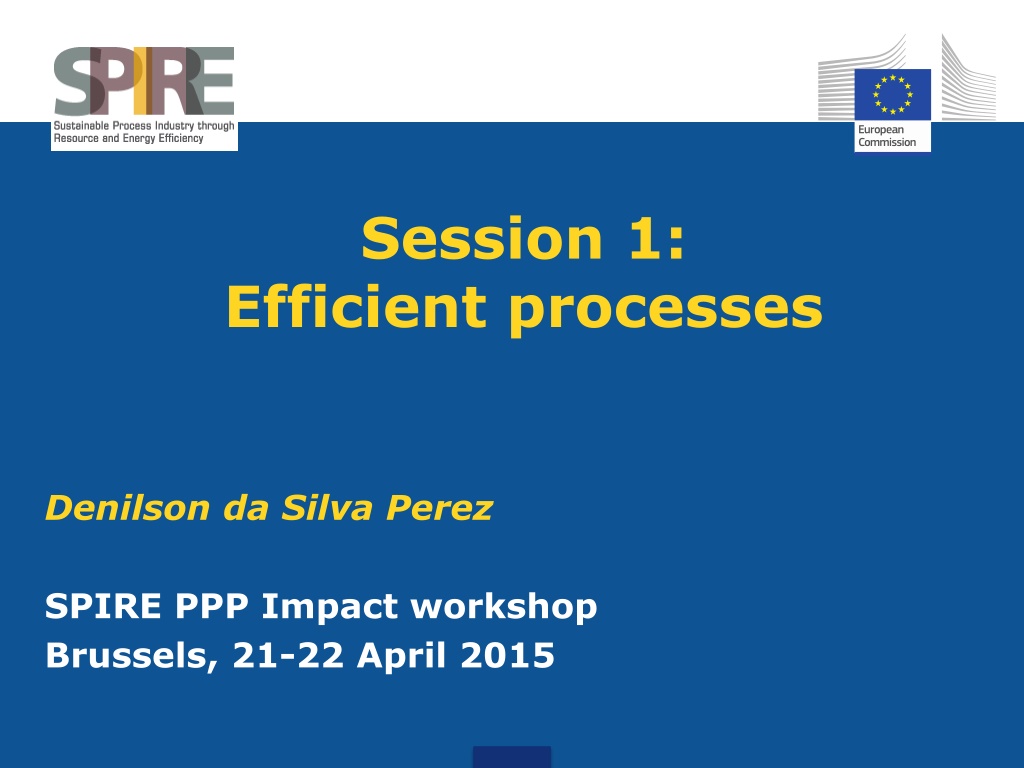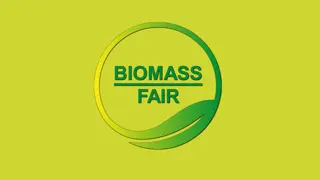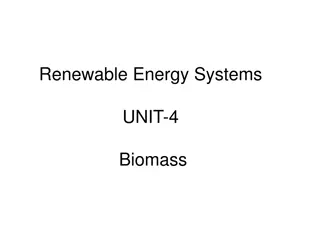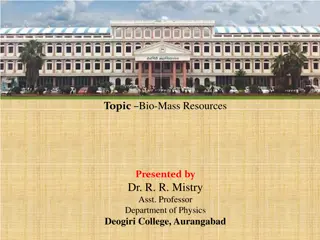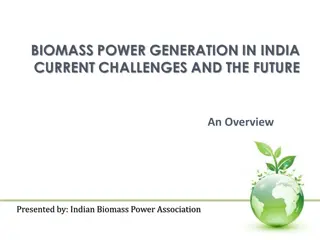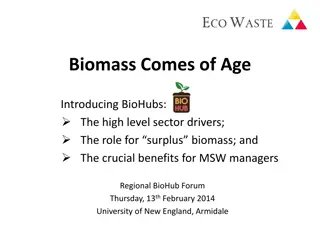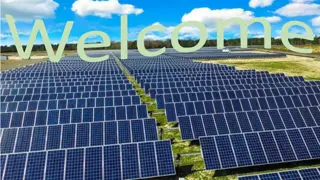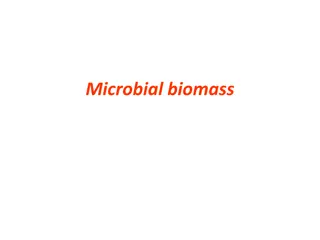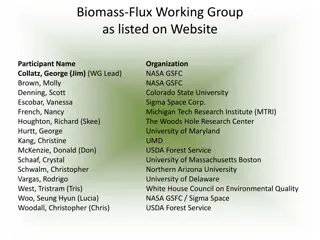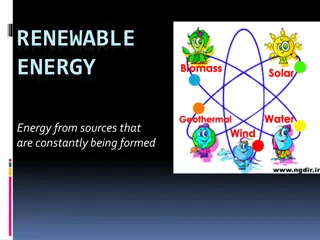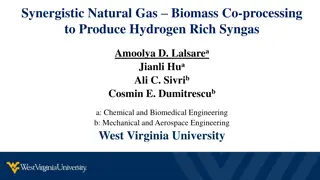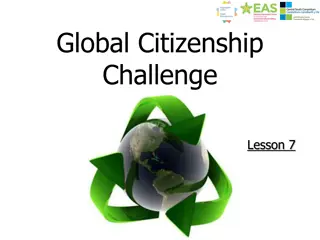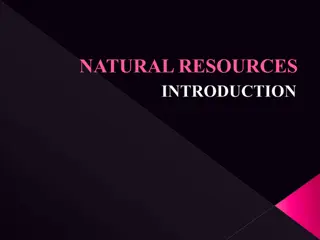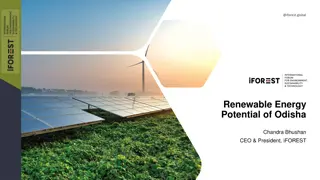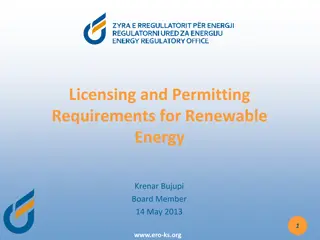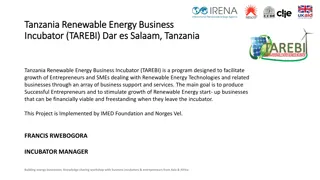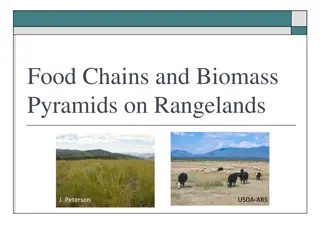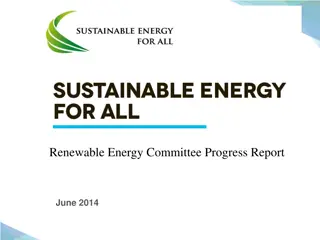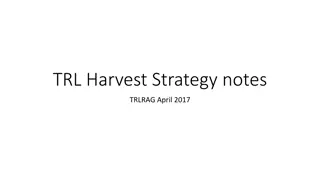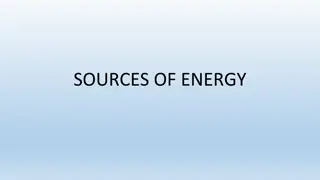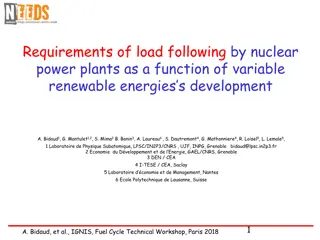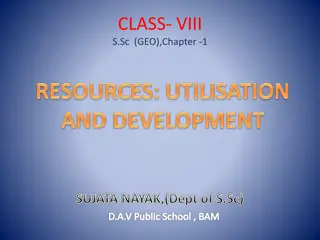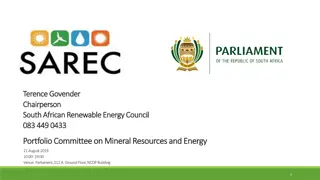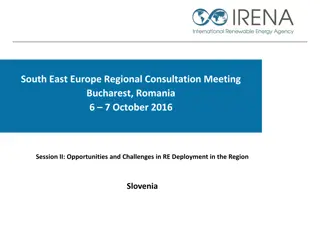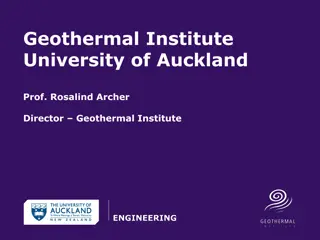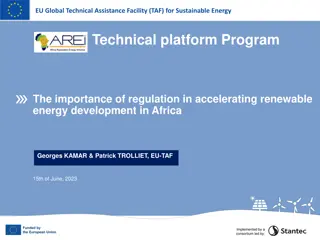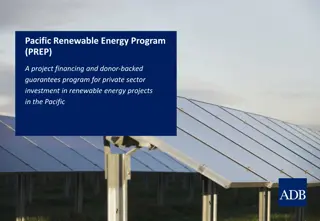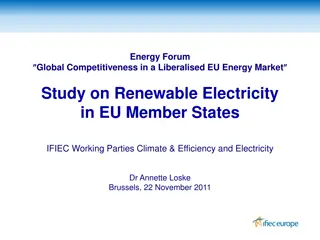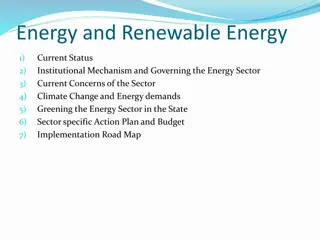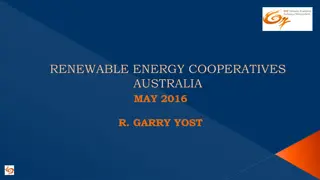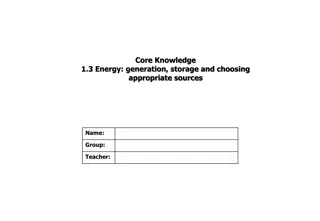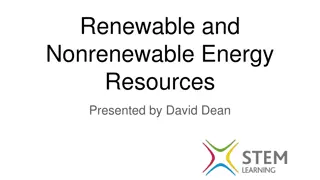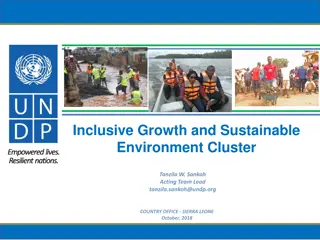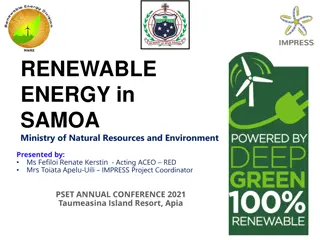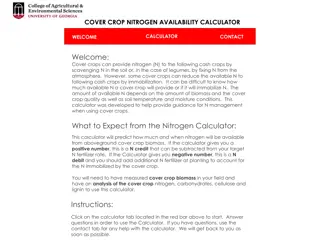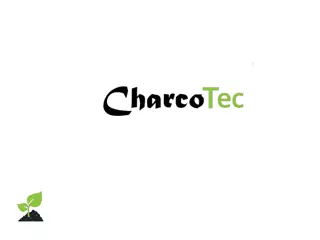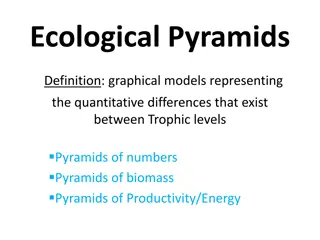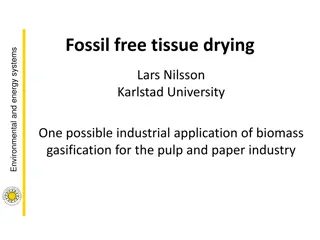Technological Impact in Biomass Processing for Renewable Resources
This content highlights the technological impact and processes involved in efficiently utilizing biomass for renewable resources. It discusses innovative methodologies to upgrade diverse biomasses for chemicals production, bioenergy, and biofuels. The development of advanced technological solutions, nano-catalysts, and demonstration units for biomass conversion and biofuel production are also covered.
Download Presentation

Please find below an Image/Link to download the presentation.
The content on the website is provided AS IS for your information and personal use only. It may not be sold, licensed, or shared on other websites without obtaining consent from the author. Download presentation by click this link. If you encounter any issues during the download, it is possible that the publisher has removed the file from their server.
E N D
Presentation Transcript
Session 1: Efficient processes Denilson da Silva Perez SPIRE PPP Impact workshop Brussels, 21-22 April 2015
Domain 2: Adaptable processes using renewables Projects: AFORE BIOGO CASCATBEL EUROBIOREF FASTCARD MOBILE FLIP PRODIAS STEAMBIO
Aggregated technological impact Renewable resources: Rationalize the use of raw materials Upgrade diverse and underexploited agro/forestry biomasses from different European regions for value added chemicals production, bioenergy and biofuels Increase the efficiency and economic viability of the transport of pre-treated biomass from decentralised rural locations to central production sites Methodologies: Innovative, cost-effective and renewable-tailored separation, fractionation and processing technologies Flexible concepts able to process a variety of raw materials Address the scalability from lab to industrially relevant scale
Aggregated technological impact Processes technologies development: Develop downsized, mobile and advanced technological solutions to valorize locally unexploited biomasses resources Validate technical suitability of processed biomass as source of value added chemicals, chemical building blocks, biofuels, bioenergy, etc. Develop innovative technologies for biomasses deconstruction, fractionation and separation Develop new efficient, robust nano-catalysts for biomass conversion
Aggregated technological impact Demonstration: Isolation of components from the side-streams of current pulp mills and novel biorefinery concepts Production of densified (pre-treated) feedstocks Mobile unit for on-site treatment of biomasses Integrated process of bio-oil conversion to synthesis gas (already widely used in industry), then to methanol and to gasoline Biomass deconstruction and production of second- generation liquid biofuels using tailored nano-catalysts.
Examples from projects (Ressources and methologies) EUROBIOREF, STEAMBIO, MOBILE FLIP: Zero-waste concept : maximum use of raw materials Upgrade underexploited and/or residual agro/forestry biomasses for bioenergy, biofuels and chemicals production ; Enable efficient transport pre-treated biomass from decentralized rural locations to central production sites FASTCARD: QSAR models transferred from conventional to renewable feedstocks based processes. PRODIAS, AFORE: Novel and cost effective tools and technologies for separation of targeted molecules from complex and diluted aqueous streams
Examples from projects (Technology development) MOBILE FLIP, STEAMBIO: Develop mobile advanced technological solutions (comminution, drying, fractioning, compaction, hydrothermal treatments, saccharification, hydrothermal carbonization, torrefaction, slow pyrolysis, etc) to valorize locally unexploited biomasses resources AFORE, EUROBIOREF, STEAMBIO, MOBILE FLIP: Validate technical suitability of processed biomass as source of chemical building blocks, biofuels, bioenergy, etc BIOGO, CASCATBEL: Develop new efficient, robust nano-catalysts for biomass conversion and second generation biofuels (syngas, methanol, gasoline) EUROBIOREF: Develop highly specific products from biomass (biojetfuel)
Examples from projects (Demonstration) AFORE: 6 separation, fractionation and upgrading process for forest residues or process side-streams demonstrated at pilot scale. STEAMBIO: Production of densified feedstocks (torrefaction/grinding) for chemical and energy applications (6 biomass, 5 locations, 500kg/h) to be demonstrated MOBILE FLIP: A mobile unit for on-site treatment of biomasses will be built BIOGO: Bio-oil conversion to syngas, then to methanol and then to gasoline (modular multichannel reactors, extended run lasting 500 hours). Prepare semi-industrial scale quantities of a selected, optimised nanocatalyst in 6 month continuous operation.
Aggregated economic/social impact Strengthening the competitiveness of the European Industry (e.g. transforming the pulp industry to diversify outputs, and retain and create employment) New business, especially for SMEs, based on local usage of co- products of forest- and agriculture-based industries generating jobs in rural areas Supporting the establishment of a more sustainable economy and the achievement of a circular economy Shorter time to demonstration at pilot/industrial scales (enabling innovation, transition from lab to industry)
Aggregated economic/social impact More efficient utilisation of resources (e.g. use of wood side streams for added-value products instead of only burning/energy source) Sustainable synfuel production to reduce import dependency and vulnerability as oil importer Improve the economy and establishing value chains for the supply valuable biomass components (e.g. transportation of pre-treated/ enrichment biomass) Nanocatalysis can help reducing the EU dependence on imported rare earths/precious metals
Aggregated environmental impact Supporting major SPIRE objectives (reducing the overall energy consumption, increased utilisation of renewables in industry, product zero waste, reduction in GHG emissions, reduction of water usage) Valorisation of carbon feedstocks in value added molecules or materials rather than direct use as energy source (CO2 release), supporting a more efficient cascading use of biomass, while avoiding competition with food production Replacement of oil-based chemicals, including inorganics Higher eco-efficiency via atom-economical transformations Better catalytic selectivity to reduce waste and emissions
Examples from projects EUROBIOREF Zero-waste concept for rationalizing the use of taw materials FASTCARD: Addressing viable approaches for co-processing bio-based feedstocks PRODIAS Reduction of energy consumption by an average of about 20% Reduction of needed energy to operate rotating separation equipment by 30 % AFORE LCA for separation, fractionation and upgrading process for forest residues or process side-streams
Examples from projects MOBILE FLIP, STEAMBIO : Reducing the use of fossil energy in particular for transportation due to increased energy density Add value to waste (forest and agriculture by-products, food industry residues, demolition wood, etc) Substitution of non-renewable phosphorus, improvement of soil quality by the biochar issued from hydrothermal carbonisation CASCATBEL Safer, greener nano-catalysts with minimum chemical waste. BIOGO Higher resource efficiency by better catalytic selectivity
Technical cross-cutting issues New technologies Efficient separation and up-grading of all valuable components of biomasses and processing side-stream (biorefineries) Inherent flexibility for different agro-forestry biomasses Scalable, compact/containerized, autonomous mobile treatment systems Energy collection, storage and reuse Process monitoring, control and optimization Modelling tools supporting transition from lab to pilot Development of toolbox applicable for other sectors of the process industry Modelling at atom scale
Technical cross-cutting issues Standardisation Methods and standards for advanced characterization of raw materials and pre-processed materials Methodologies and tools for technico-economic, costs, market, socio-environnmental assessments Establishing baseline for linking lab/pilot. Transfer of modelling approaches to biobased processes.
Examples from projects EUROBIOREF Example of full integration of the whole biorefineries value chain FASTCARD: Models for lab to pilot transition PRODIAS Hybrid technologies combining low energy and selective separation technology technologies in combination with an integrated design approach AFORE - Techno-economic feasibility of wood component separation, fractionation and up-grading processes
Examples from projects MOBILE FLIP, STEAMBIO : Methods and standards for advanced characterization of raw materials and pre-processed materials Scalable, compact/containerized, autonomous mobile treatment systems BIOGO, CASCATBEL Novel advanced energy technologies, including monitoring, control, optimisation and containerisation Process intensification and new scale-up concepts Higher resource and energy efficiency
Non-technical cross-cutting issues IPR / licencing Classical dissemination activities (website, leaflets, newsletters, scientific publications, specialized press publications, national and international conferences, workshops, etc) Demonstration technical meetings Training, creation of specific master courses Cross sectorial technology transfer (forest/agriculture, thermal/biotechnologies) Business plans, creation of start-ups/spin-offs, commercialisation Clustering
Examples from projects EUROBIOREF 33 patents, TRL 1 to 9, start up creation, 5 value chains designed FASTCARD: Aiming to achieve higher profile through common platform (News media/workshops/newsletters/etc) with related projects. PRODIAS Ensuring that the project results will live on in a commercial context after the project closure AFORE - 2 pending patents, participation at StarColibri cluster of FTP, 4 workshops, 40 publications,, 4 PhD thesis, 15 master thesis
Examples from projects MOBILE FLIP Specific actions of dissemination such as the demonstration technical meetings (DTM) One entire WP devoted to business plans covering different topics (technology, raw materials availability, demand and logistics, legislative and standardisation issues, funding possibilities) STEAMBIO : Progressing of European Bio-Economy at large scale by enabling flow of solid carbon-mass to the chemistry sites. BIOGO Business deployment (Scaling up activities of nano-catalyst production by an industrial partner)
Potential for further synergies and recommendations for follow-up Common database for mailing purposes of SPIRE projects Common public workshops involving the SPIRE projects Common demonstration activities Calendar of public projects activities (workshops, demonstrations, etc) in the webpage and SPIRE newsletters Communication of SPIRE programme with highlights of the projects in conferences (EFIB, Plant Summit, ECB, etc) and specialized/wide-public journals More information about the projects on the SPIRE website (partners, duration, objectives, etc.) and links to projects websites SPIRE asbl to support in dissemination activities
